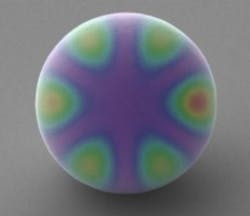Forming silicon into microscopic spheres forces it to absorb infrared light, enabling better photodetectors and solar cells
| A depiction of a Mie mode is overlaid on a scanning electron micrograph of a polysilicon microsphere. (Image: UPV/CSIC) |
A team of Spanish researchers has developed a way for silicon (Si) to absorb wavelengths in the IR that it is normally transparent to, potentially enabling more-efficient photovoltaics, as well as Si photodetectors that can function in regions of the IR that were formerly inaccessible to Si-based devices.1
The approach consists of shaping polycrystalline Si into microspheres that form resonators supporting so-called Mie modes, resulting in long photon dwell times and thus eventual absorption.
The researchers, from the Universitat Politècnica de València (València, Spain), the Spanish National Research Council (CSIC; Madrid, Spain), the Universitat Politècnica de Catalunya-BarcelonaTech (UPC; Barcelona, Spain) and the Universidad Rovira i Virgili de Tarragona (Tarragona, Spain), fabricated individual intrinsic Si 2.9- μm-diameter microspheres on an n-type Si substrate and measured the photoresponse, confirming the improved photoresponse.
For example, the absorption at a Mie resonance at 1245 nm was increased by more than a factor of three over a nearby nonresonant wavelength (1300 nm).
REFERENCE:
1. M. Garin et al., Nature Communications 5, No. 3440 (2014); doi:10.1038/ncomms4440
